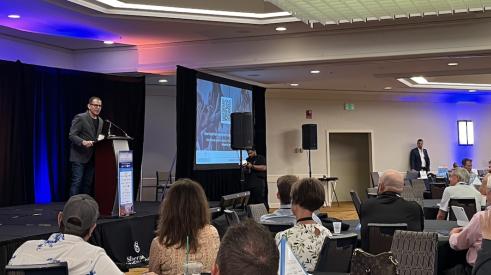As a 20-year remodeler who came from the tech sector, I’ve been driving the adoption of software in our business from day one.
When we started, we had a reasonably good CRM, a robust, but complex, estimating system, and we used QuickBooks as our accounting platform. The rest of our business processes and tasks employed a combination of offline spreadsheets. We also used a mix of cloud-based general purpose tools, along with traditional job binders.
Over the years, we added efficiency, streamlined our number of software tools, reduced dependency on printed information, and made more information accessible to everyone in the company.
In doing that, we wanted each change to be as seamless as possible.
I’ve heard too many stories of remodelers who pick a software tool with no real plan to deal with the challenge of making it all work with their people. Change management has as much to do with success or failure than the actual software you choose.
Here are six key factors that helped us maximize our success:
1. Document Processes and Map Current Software Tools
It has been said that if you automate a bad or poorly defined process, you’ll get more bad information faster!
Before you make any changes, you need to know the current state of how your processes link. Take the time to define and capture them in written and/or graphic form. Then, create a relationship map of the current software tools and/or documents you use to move information within and between departments. Use arrows to show how data flows.
This will help you discover bottlenecks and opportunities for improvement. It will also aid in evaluating the critical areas of need in choosing new technology for your business.
2. Focus on One or Two Critical Areas First and Set Realistic Goals
After our evaluation, we decided to implement Buildertrend. Over time, we dropped some of our other software and incorporated those functions into Buildertrend.
For example, we moved our production scheduling and our design selections spreadsheets from Google Drive into Buildertrend. These were labor-intensive spreadsheets to manage, but provided real benefits. We targeted to complete these in the first 60 days.
3. Assign Advocates within Key Functions to Lead Change Efforts and Give Them Time for Success
The move from Google’s system over to Buildertrend was potentially disruptive, but two factors made the migration go smoothly.
First, the decision for the change came from my production and design managers. This ensured they would be committed to success.
Second, these were the individuals who managed the teams implementing the new system. They set aggressive, but achievable timeframes to design, test, and complete the migration. If you have managers reporting to you, make sure they are not just involved but committed. Otherwise, the “death zone” of change can be the managers in the middle.
4. Ensure Cross Functional Cooperation and Communication
As information flows through your processes, some departments are the source of the information and others are users. This is important to keep in mind.
If one department changes the content or format of the information they provide, they need to be mindful of the impact on users in other departments. For example, data from the marketing department impacts sales and the way designers enter information impacts production. Users in other departments need to be consulted on any proposed changes that impact them.
5. Get Your “Hands Dirty” and Lead the Action (or Assign Someone to Lead)
If you’ve decided to implement new software, you’d better be committed and not just involved. Knowing your business processes at least at the highest level helps you make good prioritization trade-offs and helps resolve conflicts between functions when they inevitably pop up.
If you manage a larger organization, this might be a great initiative for one of your key lieutenants to manage as a development opportunity.
6. Be Willing to Adjust Some of the Details of your Processes
Several larger remodeling companies have hired software development companies to create custom software to run their businesses. There are pros and cons to this regardless of size, but for most of us, this is not practical or feasible.
As a result, there will be certain functions that new software does not include and/or there will be aspects of “off-the-shelf” software that won’t exactly fit the way you work. This can lead to resistance to change that might generate pushback from your team.
You can either continue using some of the current or offline tools and stay true to your current state or make the changes to keep things simpler.
Don’t let the “perfect” be the enemy of the “good” if you can make it work. I believe the benefits of an integrated information flow usually outweigh our biases about doing things “the way we always have” in separate “islands of automation.”
Comments (2)
Add new comment
Related Stories
Brian Gottlieb Receives Remodeling Mastery Award
Presented by industry icon, Mark Richardson, the award celebrated Gottlieb’s extraordinary impact on remodeling
What's Beyond the Hammer?
Working with Brian Gottlieb on the book Beyond the Hammer provided a masterclass on how to build an aligned team
Real AI Applications For Remodelers
Tech-forward remodeler Michael Anschel shares how he uses artificial intelligence in his business.
How to Eliminate Boring, Languishing Meetings
Leff Design Build ensures maximum productivity and efficiency through these straightforward methods
5 Counterintuitive Strategies to Improve Your Business
Follow these strategies to inspire employees, instill trust, and beat the competition
Couple Act As Much More Than General Contractors
How LBR Partners uplifts and educates their Spanish-speaking trade partners
Artificial Intelligence Meets Design
An architect looks at the pitfalls of using technology to take over human design tasks
How to Correctly Hire for Business Growth
Refloor CEO Brian Elias shares exactly how his company hires the correct people for the correct seats
Managing Business Risk to Embrace Risk
As remodelers, our product is risk. Yet within our businesses, we fear risk. Just like with your projects, if you plan accordingly, your risk comes with reward
What the Most Successful Remodelers are Doing Right Now
Industry advisor Mark Richardson shares the answers to his three most asked questions: What's the remodeling market like? What are other remodelers doing? How do I measure up?














Great tips!
Submitted by Jessica (not verified) on Mon, 05/13/2024 - 20:02
Great tips!
Very much enjoyed the read—same tips apply across various sectors!
good insight and actionable…
Submitted by Rachel (not verified) on Tue, 05/14/2024 - 21:31
good insight and actionable…
good insight and actionable advice